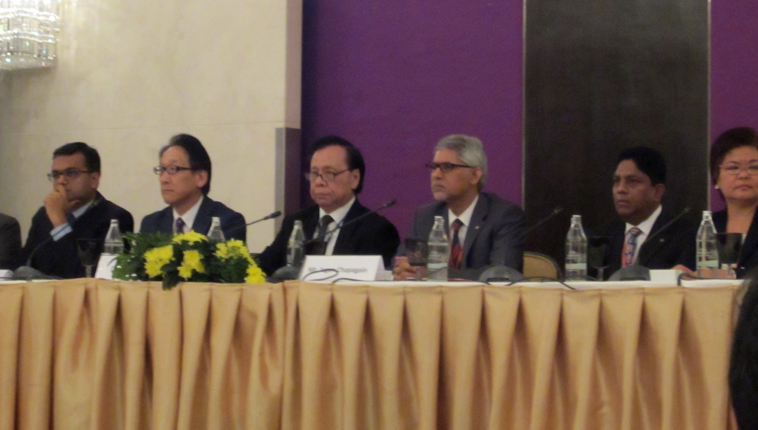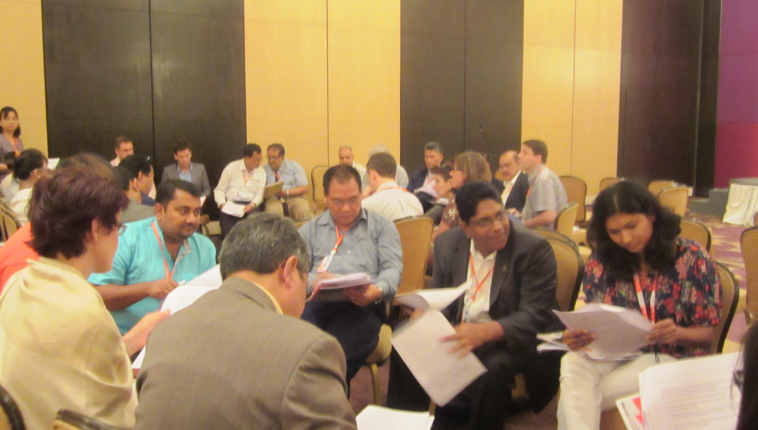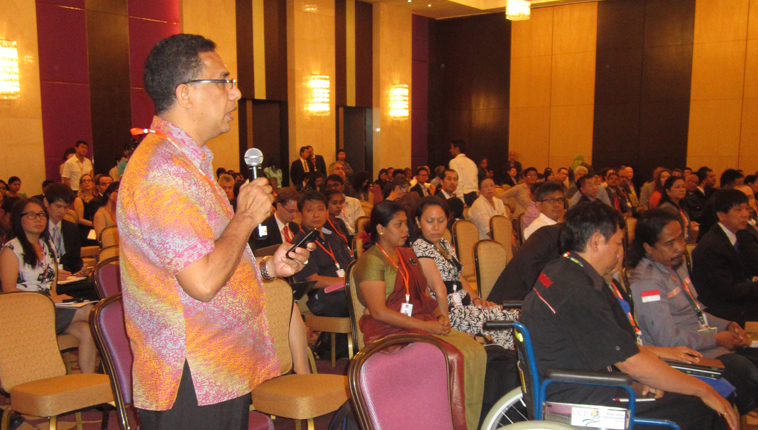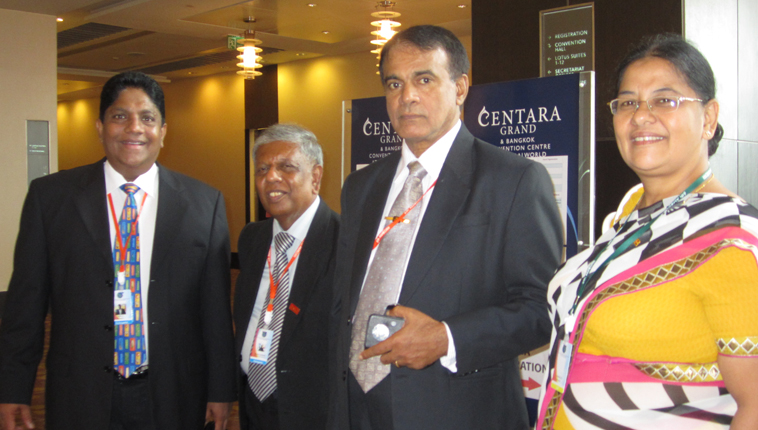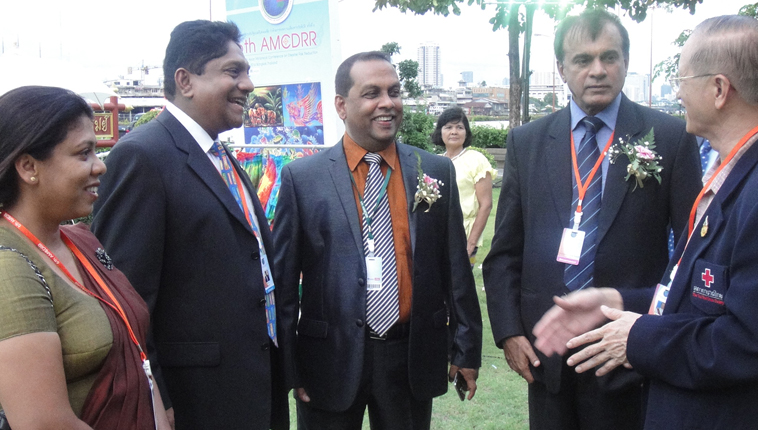Red Cross calls for bigger role for children, youth & women in enhancing resilience
25/06/2014 – Bangkok, Thailand: As key leaders from Asia gather for the 6th Asia Ministerial Conference for Disaster Risk Reduction (6th AMCDRR) in Bangkok, the Sri Lanka Red Cross (SLRCS) along with other national societies and the International Federation of Red Cross & Red Crescent Societies (IFRC) is calling for greater commitments towards preventing and reducing the impacts of disasters on vulnerable communities.
The Red Cross are encouraging governments and other stakeholders attending the AMCDRR to increase their engagement with ‘at-risk’ communities, local leaders and civil society to reduce risks and strengthen resilience.
“When disaster strikes, it doesn’t matter to beneficiaries whether it’s IFRC or UN or someone else responding; they just need support,“ said Jagan Chapagain, IFRC’s Asia Pacific Director as he chaired the first technical session on local level resilience at the 6th AMCDRR along with the Director General of the Sri Lanka Red Cross Tissa Abeywickrama. “We must be more integrated. We must not simply allocate responsibilities in implementing DRR, but also resources supported by policies and laws that can be enforced.”
These opening remarks set the tone for thoughtful dialogue between conference delegates and diverse panelists such as government representatives from Myanmar and India to officials from Tohoku University and Sri Lanka Red Cross.
The Director General of Sri Lanka Red Cross Tissa Abeywickrama was one of the keynote speaker at the Technical Session (1), which focused on enhancing resilience at local level. Only several people were selected for presentations out of over 30 participants. The technical sessions were one of the biggest events held at the conference which was only seconded to the Ministerial Conference.
Women’s empowerment is community empowerment. Youth and children focused DRR is critical. These were some of the main themes expressed by participants.
“Asia Pacific contains 60 per cent of the world’s young people. Youth and children focused DRR is essential,” said Director General of Sri Lanka Red Cross Tissa Abeywickrama.
“During the Great Indian Ocean Tsunami in 2004, many young people did not know where to go or what to do. Since then, Sri Lanka Red Cross youth volunteers have trained in early warning, hazard assessment, first aid, camp management and more.”
The role of women and their capabilities, not just vulnerabilities was also discussed. One delegate posed this question: “How can women’s groups have a formal partnership role with access to adequate resources in DRR?”
Delegates agreed that to preserve development gains, the resilience agenda must be a responsibility shared by all.
Here’s the full speech made by the Director General of Sri Lanka Red Cross Tissa Abeywickrama
6th Asian Ministerial Conference on Disaster Risk Reduction
Bangkok, Thailand – 22-26 June, 2014
Technical Session 1 – Speech of Mr. Tissa Abeywickrama, Director General, Sri Lanka Red Cross
Enhancing Resilience at Local Level: Young Citizen Volunteers- the underestimated potentials
The Asia Pacific contains 60% of the world’s youth population, and the predictions suggest that by 2015 more than 175 million children will be affected by weather related disasters. We need to support and strengthen meaningful participation of our children and youth in Disaster Risk Reduction (DRR).
Among many I recall the adversities of Asian Tsunami 2004, in Sri Lanka alone it killed 35,000 people and over half a million lost almost every belonging. However, the way the people reacted to assist each other was astonishing. They swiftly engaged in lifesaving, caregiving and other assistances.
This scenario with people’s selfless prompt actions to help others was like a robotic program. Of cause there were gaps and overlaps. Thousands of our Red Cross volunteers were also active in the affected areas. As is always the case in spontaneous mobilization and outpouring of humanitarian goodwill, youth majorly volunteered in helping others. However if they had specific skills in response, their efforts would have been much more collective and effective.
Community Resilience I believe is the ability; for a collective response and recovery mechanism, included with a right mix of knowledge on probable adversities, ways to mitigate and the use of resources efficiently without compromising their long term prospects. Further, it is significant to understand the available human capacity in diverse tasks.
Resilience is not an overnight gain. It is an inherent dynamic ability of the community that require long-term engagements and investments. Skilled youth volunteer base herein is vital. Recognizing the importance of institutionalized systems, my effort here is to exhibit the potentials of our young community volunteers as a foremost joint in the community resilience endeavor. Enthusiastic, energetic and versatile these young volunteers are at first hand to assist.
I have watched through public media many efforts of youth volunteers in other countries; typhoon “Haiyan” in Philippines, Tohoku earthquake in Japan, typhoon “Nari” in South Korea, Cold disaster in Thailand, Floods in Southwest China, Blizzard in Afghanistan, Earthquake in New Zealand, Earthquake in Pakistan and Cyclone Nargis in Myanmar are just a few of those.
Also I was surprised when I heard that the tribal group “Sentinelese” in Andaman Island had neared no harm from Asian Tsunami 2004, I ask; “Was it because of their pre-imbedded community resilience brought down through their indigenous culture?
With technological advancements, now we have faster ways of conveying messages through social media. Especially youth being the drivers of social media they can amplify our forefathers’ behavioral patterns of community resilience, if youth contribute to introduce pragmatic approaches in networked and coordinated DRR.
Using available resources at Sri Lanka Red Cross, we have trained young volunteers in varied purviews; Hazard, Vulnerability & Capacity Assessments (VCAs), early warning & mock drills, first aid, search & rescue, camp management and water safety are some of them. Importantly our local Disaster Response Teams work together with Village Disaster Management Committees (VDMCs) established by the Ministry of Disaster Management. In this set up, we work very closely with such mechanisms at all levels.
Also the “Integrated programme for community resilience (IPCR)” we implement in Sri Lanka is a multi-sectoral programme assisting the local communities to build resilience. The significance of this programme is upon relevant VCAs carried out by the community together with our technical support, the community is the ultimate decision maker on their priorities for their own resilience building. To enhance resilience at local level, we have to recognize the potential of Young Citizen Volunteers. In this regard I assert you the following;
Depending on the type of disaster certain few first hours are considered as crucial, Therefore, if capacities of primary respondents in high risk areas are enhanced to reduce risks, to prepare for and respond to disasters, a higher degree of damage to human, property and livelihood aspects can be reduced.
As children and youth are especially vulnerable in disaster situations and face particular risks to their health, protection, access to; education and nutrition, we need to ensure youth-centered DRR and development initiatives.
The volunteers living in the community, including the youth volunteers, have indigenous knowledge and are familiar with their localities. Therefor children and youth should be regularly involved in long term sustainable disaster and climate risk reduction programming.
A synergy between scientific and traditional knowledge is important to enhance community resilience and enabling youth to share these with other groups in their communities will encourage wider familiarization and acceptance to new approaches.
A disaster preparedness plan should become a component of school curriculum. Also schools should be adequately equipped with resources to implement this plan to make the school a safer place. This would enable to develop a culture of safety among children and youth. We need to enrich First Aid training in schools which is sadly not a minimum standard everywhere.
To enhance community resilience; we (International Federation of Red Cross & Red Crescent societies) or other institutions or communities cannot work in isolation, thus working together with community’s own plan is pivotal to underpin the potentials of community volunteers. Youth are the agents of behavioral changes in the society. There should be more opportunities for them to enhance their capacities and expose for collective resilience building initiatives. Sufficient investments should be made continuously to enhance the capacities of youths.
Institutionalized approach orientated towards sustainability is significant. However in these efforts, young citizen volunteers should be the foremost drives in resilience building endeavors.
Ends/-
